Sublimation of Apparel: Unraveling the 12 Hidden Benefits of Customized Clothing Beyond Aesthetics
In the dynamic world of apparel customization, sublimation has emerged as a revolutionary technique, offering not only vibrant designs but also a myriad of hidden benefits. Beyond the eye-catching aesthetics, sublimated apparel stands out for its durability, breathability, and versatility. In this comprehensive exploration, we unveil the often-overlooked advantages of sublimated clothing that make it […]













